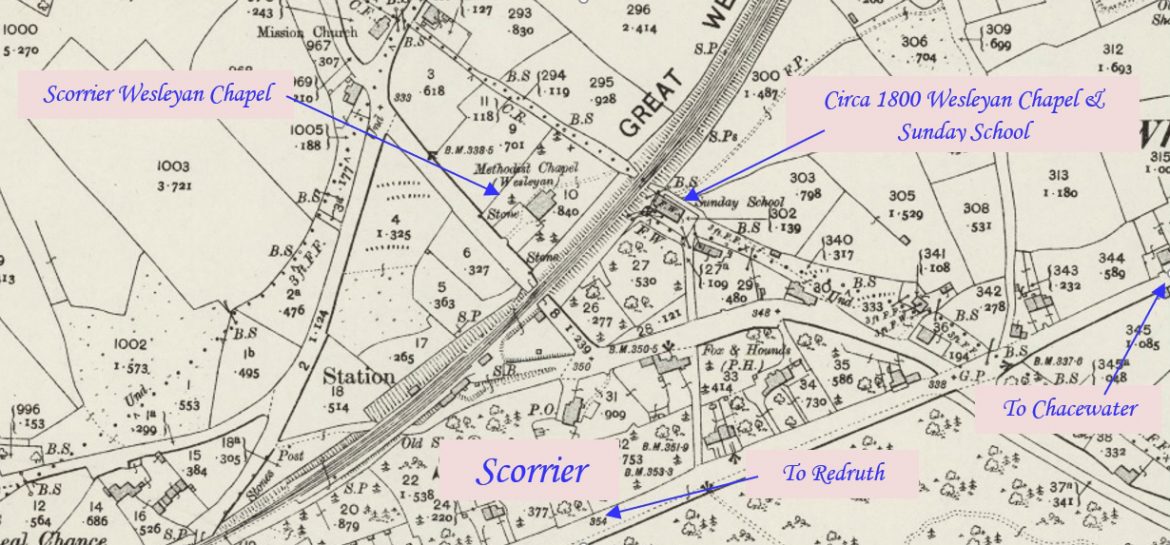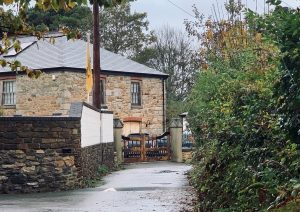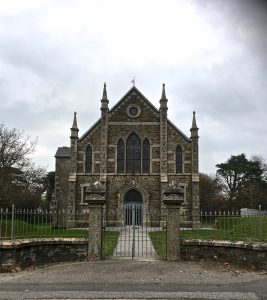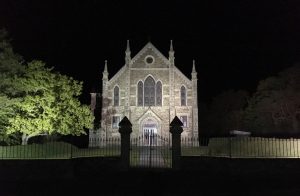
Scorrier is a village in the civil parish of St Day, about 2 miles northeast of the centre of Redruth and 3 miles southeast of the coast at Porthtowan. This profile of Scorrier Chapel has been compiled by Jo Lewis and Tony Mansell.
1800: Wheal Rose Wesleyan Chapel built. (SWChurches)
Taking the next left which runs back towards the A30. Just opposite the turn back to the Fox and Hounds pub, is a small lane to house on the south side of the railway. Down here, on the left is the first Wesleyan chapel. It was also known as Wheal Rose Wesleyan Chapel because of the local mine (although in modern times, the area of Wheal Rose is thought only to be on the other side of the ‘new’ A30). It was built as a Wesleyan chapel in 1800. (Jo Lewis)
30 Dec 1882: Declaration of trust, Wheal Rose Wesleyan Chapel, Kenwyn. Trustees: John Merrifield, farmer; John Bawden, postmaster; William Pengelly, railway signalman, all of Wheal Rose; Humphry Trembath Williams, draper; William G Wilton, ironmonger; James Wickett, accountant; and Alfred Lanyon, merchant, all of Redruth. Recites memorandum of agreement of 6 March 1883, the date being inserted after the document was written out. (Kresen Kernow MRR/1727)
1883: Lease, Wheal Rose Wesleyan Chapel, Kenwyn. Parties: 1) Right honorable Evelyn Viscount Falmouth 2) John Merrifield, farmer; John Bawden, postmaster; William Pengelly, railway signalman, all of Wheal Rose; Humphry Trembath Williams, draper; William G Wilton, ironmonger; James Wickett, accountant; and Alfred Lanyon, merchant, all of Redruth. Chapel trustees. Wheal Rose chapel, ‘as now and for many years past used for divine service and preaching by the people called Wesleyan Methodists’. Tenants to put buildings and premises in good repair within a year. Consideration: yearly rent of £1. Term: 21 years from Michaelmas 1882. (Kresen Kernow MRR/1728)
1885: Corner stones of new chapel laid. (Cornubian and Redruth Times – Friday 17 July 1885)
Circa-1885: Chacewater Wesleyan Chapel built to replace Wheal Rose Wesleyan Chapel, situated on the other side of the railway line. (SWChurches)
From the first chapel, travel under the railway bridge and the second Wesleyan Chapel is on the right, opposite Cross Roads care home. The Chapel was built in 1885 to replace the older Wheal Rose Chapel on the other side of the railway line (see previous). It was constructed to a design possibly by James Hicks and incorporates a fine granite-dressed three-bay gothic facade. (Jo Lewis)
Seating for 330. (David Easton)
1886: “For years past the Wesleyan Chapel at Scorrier has been unsightly and inconvenient; in consequence, about twelve months ago steps were taken to secure a new one. George Williams, Esq., of Scorrier House, generously gave an eligible site of nearly an acre, contiguous to the old chapel. A very handsome building has now been erected from plans and specifications prepared by Mr John Symons, of Scorrier. The chapel is about 52 feet by 40 feet, with spacious orchestra and vestry at the back. The front front of the building is of Gothic style, and built of local stones, with granite facings; and formed into bays buttresses with pinnacles on the roofs. The windows in front are of ornamental design, and cathedral glass, with leaded lights; the other windows are glazed with cathedral glass. The interior of the chapel is most suitably arranged. The principal timbers of the roof exposed to view are varnished; the intervening portions of the ceiling being formed of panelling. The gallery which is supported by iron pillars, beautifully gilded, extends round the chapel; the front being fitted with ornamental iron panels, nicely painted and gilded. The pews, in the body of the chapel, are set at angles, and are both spacious and comfortable. The rostrum is constructed of pitch-pine and mahogany; the upper part being filled with ornamental iron work. Underneath there is communion rail, supported by iron standards; the whole presenting a most chaste and elegant appearance. Great credit is due to the contractors Messrs. Symons, of Blackwater and Scorrier, and Mr Head, builder, Redruth, for the very satisfactory manner in which they have carried out their work. Mr Hawkins, of Truro, also deserves commendation for the artistic nature of the painting and glazing. The opening ceremony took place last Thursday, the 19th inst. when (in the afternoon, the Rev. E. Watson (chairman of the district) preached an impressive sermon. At 5 p.m. there was a public tea and a sale of work, which were well patronised. In the evening a public meeting was held. Addresses were delivered by the Rev. Watson, and Messrs. Johns (Redruth), Nettle (Mount Hawke), Chellew (Mawla), Bawden (Chacewater), H. T. Williams (Redruth), and J. Bawden (Scorrier) J. S. Ferry. Esq., (of Falmouth), presided, and contributed towards the building fund. He also directed the stewards to obtain a good clock, and send the bill to Mrs Perry, who, he knew, would be pleased to pay for it. The services were continued on Sunday last; Capt Thomas and Rev. J. Crawshaw (of Falmouth), conducting the services. ln the evening the chapel was so crowded, that many failed to obtain admittance… Over £5OO hue been raised daring the past 12 months. The total cost of the chapel is about £850.” (Cornubian and Redruth Times – Friday 27 August 1886)
1886: “Scorrier Wesleyans have built for themselves as pretty chapel could be wished…” (Cornubian and Redruth Times – Friday 30 July 1886)
The old Wheal Rose Wesleyan Chapel in use as a Sunday School until about 1945. (SWChurches)
“Revival services have been conducted at Scorrier Wesleyan Chapel during the past fortnight, with a good result. Although members have been added the Society, the Church has been much quickened.” (Cornubian and Redruth Times – Friday 21 April 1893)
1932: The Wesleyan, Primitive Methodist and the United Methodist Church amalgamated to become the Methodist Church of Great Britain.
1932: Became Scorrier Methodist Church.
Circa 1945: The Sunday School closed (seen on old maps). There are old pictures of it on the Internet showing it in ruins (See references) but was later restored to form housing, called The Chapel. (Jo Lewis)
1926-1969: Minutes, Leaders’ meetings, Scorrier Methodist Church. (Kresen Kernow MRR/1389)
1970: Photograph, ruins, old Wesleyan chapel, Wheal Rose, Scorrier, Redruth. Old Buildings at Wheal Rose. Kresen Kernow corn02373)
1970: Photograph, ruined Wesleyan chapel Wheal Rose, Scorrier, Redruth. Old Buildings at Wheal Rose (Kresen Kernow corn02371)
1999: The society left the Methodist connexion in 1999 and became an independent Methodist society. (SWChurches / David Easton)
The society left the Methodist connexion in 1999 becoming an independent Methodist society. It is currently home to the Scorrier Christian Fellowship, an Evangelical Church. https://www.scorrierchristianfellowship.org.uk/ (Jo Lewis)
A Wesleyan Methodist chapel is recorded on the 1st Edition 1:2500 1880 OS Map at Scorrier to the south of the railway line. By 1907 this building had become the Sunday school a new chapel constructed to the north which is still in use.
The (early) chapel was constructed in the late 18th or early 19th century, and in typical Methodist style comprised a single space with a small porch (now removed). In the mid-19th century galleries were added at first-floor level. The walls of the chapel were raised to accommodate these galleries and the existing window openings were altered to provide further light. A vestry was added to the northwest side of the chapel. The principal function of the chapel may have been in decline by the latter part of the 19th century due to the construction of a neighbouring larger Methodist Hall some 100m to the west. From 1907 the building was used as a Sunday School, and further alterations to the window and door openings took place. The chapel appears to have been abandoned sometime during the mid-20th century, and no internal fittings survive. (Cornwall Council mapping)
Wesleyan chapel, possibly by James Hicks. Local rubble with granite dressings; steep dry slate roof. Gothic style. 3-bay front end has buttressed bays surmounted by spirelets dividing the bays. Central bay has stepped tripartite window over gabled doorway; flanking bays have lancets over lintelled windows. 3-bay side elevations with tall pointed-arched windows. Original panelled doors and original fenestration (except for added projection to front bay of left-hand return) including coloured leaded glazing to front windows. Interior has horseshoe-plan gallery with original pews but now infilled between to separate as two floors to create schoolroom on the ground floor. One of the best Gothic style examples of this date in Cornwall. (Cornwall Council mapping)
Photographs by Jo Lewis
 Wheal Rose Wesleyan Chapel
Wheal Rose Wesleyan Chapel


